My diary
Day 76 - 13th July 14
Buses leave regularly to Penang from Kuala Lumpur. I use the hotel's phone to book a dormitory bed in a hostel. It's called Roommates and sounds like a small, friendly place, suitable for a solo traveller. I feel a pang of loneliness on the bus journey. It takes 5 hours and I read for most of the journey. I take an expensive taxi into George Town and only later discover that I could have caught a bus, but it is easier to be driven to your door when arriving alone in a strange city, rather than wandering unfamiliar streets in the dark.
Penang is famous for its cuisine and sheer variety of dishes on offer. The streets we drive through are buzzing with food stalls and people eating on plastic stalls along the pavements. Although Malaysia is a Muslim country, Penang itself, a trading epicentre for so
Georgetown, Penang - street art and crumbling mansions
Malaysia
Day 76 - 13th July 14
Buses leave regularly to Penang from Kuala Lumpur. I use the hotel's phone to book a dormitory bed in a hostel. It's called Roommates and sounds like a small, friendly place, suitable for a solo traveller. I feel a pang of loneliness on the bus journey. It takes 5 hours and I read for most of the journey. I take an expensive taxi into George Town and only later discover that I could have caught a bus, but it is easier to be driven to your door when arriving alone in a strange city, rather than wandering unfamiliar streets in the dark.
Penang is famous for its cuisine and sheer variety of dishes on offer. The streets we drive through are buzzing with food stalls and people eating on plastic stalls along the pavements. Although Malaysia is a Muslim country, Penang itself, a trading epicentre for so
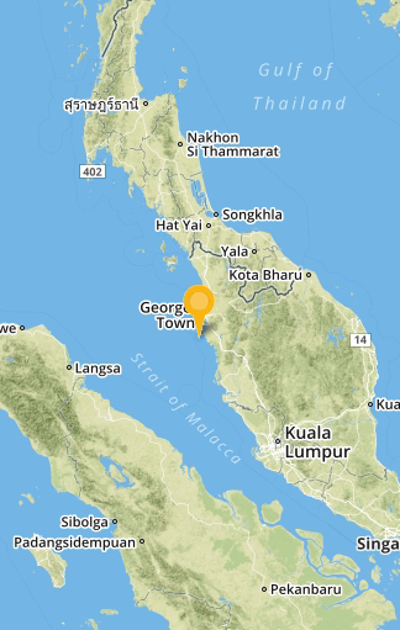
long, is enriched with a multitude of differing cultures, seemingly working in perfect harmony, so there is no issue imposed by Ramadan for finding food throughout the day. The hostel itself is small and clean with 2 dorms, shared bathrooms and a small communal area. I like the simple decoration of concrete floors bordered by patterned black and cream tiles downstairs. The dorm beds have curtains for privacy.
I head to Little India in George Town to eat. I am accosted by a solitary man carrying a map and looking a little lost like me. He says he is from Bangkok and asks if he can join me for dinner. I feel it would be impolite to decline, but upon realising he wants me to mount the back of his scooter, I rapidly change my mind, not wanting to put myself in a vulnerable situation where I am not in control of my destination. He asks if I am scared of scooters and I nod my head in agreement at this perfect excuse, not wishing to offend him since I am sure he is harmless. I eat a at Karai Kudi - garlic naan, a pea and cauliflower massala and a spinach dish which appears in the form of a green soup. I get an early night ready for a day of sightseeing.
Day 77 - 14th July 14
I walk the recommended route found in the Lonely Planet guide around George Town and spend a couple of hours in the Penang museum. It is situated in a beautiful colonial building on Farquhar Street not far from the hostel. The first room lists and describes the races of immigrants from different countries that set up communities in Penang, creating this now cosmopolitan city. The museum houses furniture, household tools, wedding-garments from the differing cultures. It especially focuses on the Baba-Nonya - the name given to the descendants of the early Chinese immigrants who adopted some of the Malay customs and created a distinct community. I take a particular interest in a large, round metal object called an iron tungku, reportedly heated and used to flatten women's stomachs after childbirth. There is also a photo on display of an old Chinese lady's foot from Penang showing the brutal effect of binding. The upstairs rooms focus on the British colonisation of the island, from when Captain Francis Light arrived in Penang. He utilised the island's perfect location for trading. The museum showcases the most expensive, sought after spices that were later grown and exported from the island. The different modes of transport around Penang and an old carriage from the original train that carried visitors and locals up to the top of Penang Hill, sits outside the museum.
There is a small section remembering the brutal invasion of the Japanese, when the British left the islanders to fend for themselves, choosing to use all their military defence to protect Singapore, after which the island's economy was ruined. Pictures are mounted on a wall in a separate gallery - landscape scenes of Penang painted by British artists, including images of Halliburton Hill (the same name of the road where my family home is located in London).
Walking from there past the High Courts to the sea front, there are views towards the built up, high-rise area of Penang. A wide, concrete
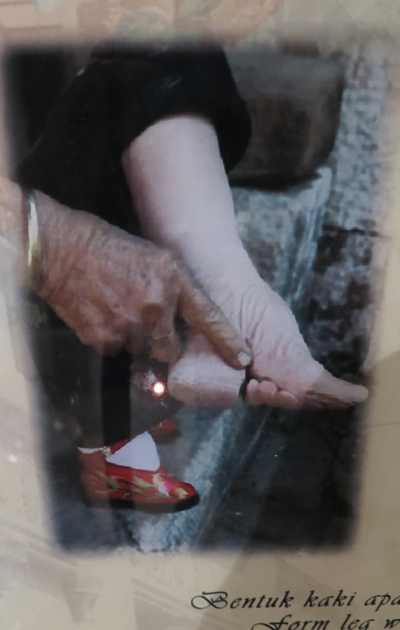
promenade empty except for the squawking, black crows swooping down from the trees. There are a few tourists in Fort Cornwallis - a desolate fort made from red brick, canons still in their original place on the corners overlooking the sea. Dry, brown grass fights to grow in its centre and there is little of interest to see, except a small bare chapel where Cornwallis was married, and information about his life housed in the small cell like rooms in a low long white building which runs along the roadside. The sun is hot and there is no shade in this open expansive area.
To visit the Pinang Peranakan (a Baba-Nonya mansion) costs 20 MYR, but this does include a short tour. Our guide is a student. His English is passable and although he's able to regurgitate the information he has been taught, he is easily confused by additional questions outside of the memorised script. There is a seemingly eclectic collection housed in the building including: opium beds; full
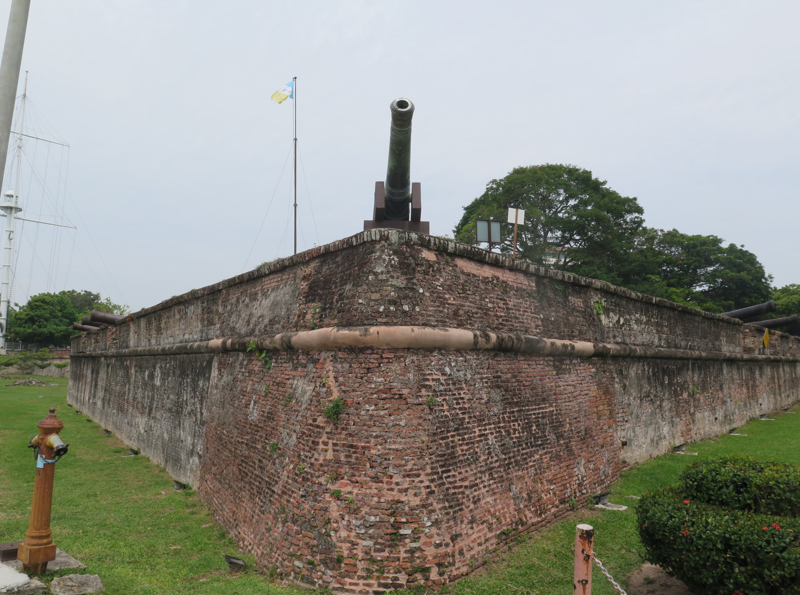
sets of crockery for entertaining vast amounts of guests; a room of flower shaped, colourful glass lamps, fashionable at the time, imported from England; sewing machines in the ladies bedroom; an interestingly shaped double chair, where a couple introduced to each other for the first time can converse; a room with a 1950s television set, record player and radio; antique jewellery, some of which is on sale.
The current owner bought the house as a shell, of which there are photos hidden behind the entrance door into the museum depicting the state of the mansion prior to its renovation, but we are not able to discover from our guide whether the owner researched the use of each room and attempted to recreate what was previously there, or if he just used the given space as a museum to house his collection. The outside court is original, the paint now dull, the decorative roofs beautiful. A few hundred bats live in the rafters, swooping across to
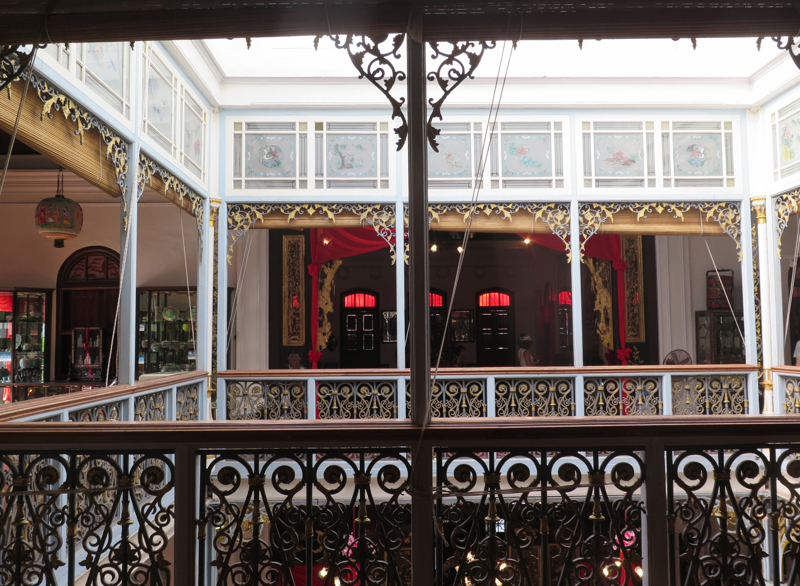


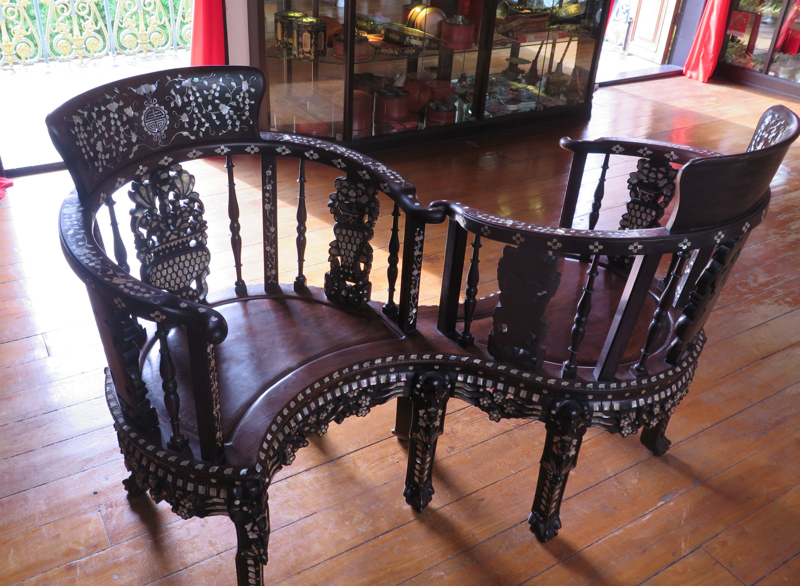
the opposite walls, hanging visible in the daylight - they were apparently kept by the owners - a Chinese sign of good luck.
Khoo Kongsi mansion is closed when I arrive. My walk passes through the old Chinese quarters, alive with a sense of the past - the colonial terraced houses, with wooden shutters above the shop fronts, the once colourful paint faded and flaking, lined along narrow dusty streets. Cement has dropped in chunks from walls, uncovering patches of terracotta brickwork.
A motorbike leans against a red, wooden door, above which is painted a seated boy riding the bike, glancing furtively behind him - a permanent creative fixture on the door. Against a barred window, 2 rough, miniature figures stand next to a POLIS sign handwritten on a small paper umbrella - a man mugging a lady, playing tug of war with her handbag and brandishing a tiny cardboard knife. Around a
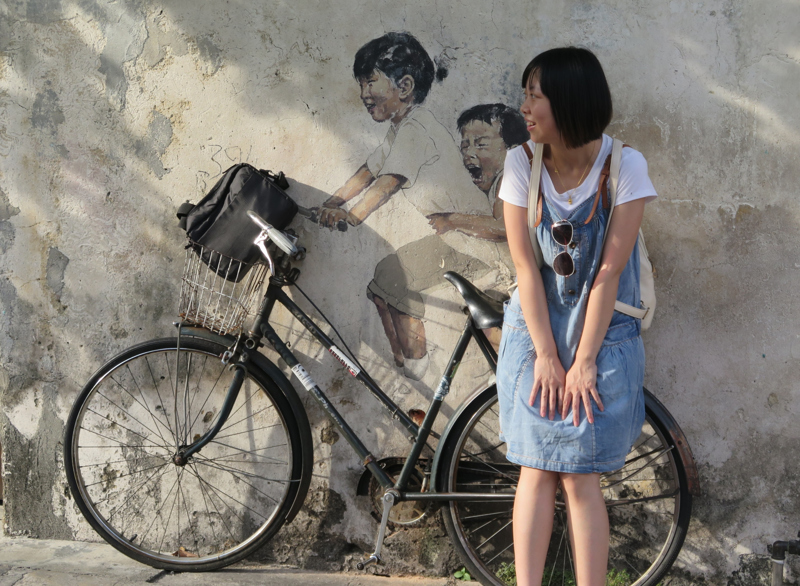
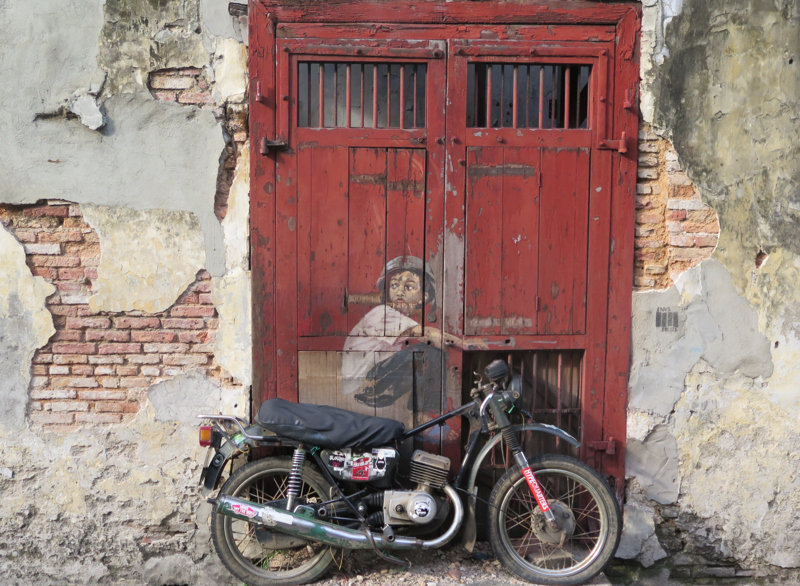
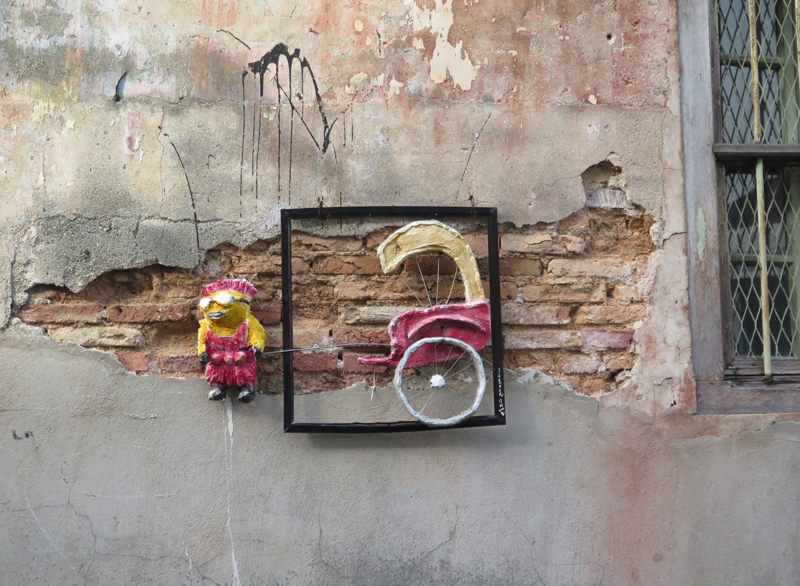
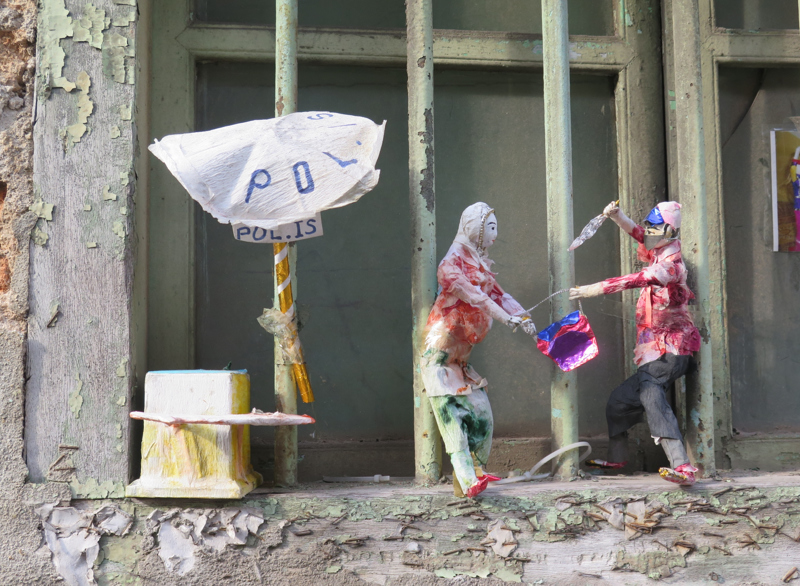
corner I stumble across a ladies bicycle with a white rusting metal basket similarly stood against a wall, which a young girl with a cheeky smile is riding, her younger brother clutching his arms around her waist astride the back. Here there is a group of Indonesian tourists queuing up to get a picture next to this street art.
There are beautiful murals graffiti'd all over George Town as part of the Penang 2012 Art Festival. I notice people with maps that indicate the location of the different pieces - they have clearly become a bit of a tourist attraction and I can understand why - intricate and lifelike against the crumbling walls, oozing with personality. The sun is beginning to set and the light is yellow. I wonder the streets searching for similar pieces.
A young boy standing on a wooden chair, stretches his arm up desperately reaching for a paper cup in a recess in the wall; a graceful, dancer pirouettes above an archway on Lorong Stewart, her black hair cascading downwards; next to a Hindu temple, a gargantuan girl with pig tails and a long blue gown pushes herself up on 2 small protruding windows; a barefooted Indian man, larger than life, wearing a turban, stands adrift a wooden boat holding an oar, against the side of a sandy-coloured, ageing house on Lebuh Klang; the mural of an old man sits resting in the carriage of his tuk tuk,
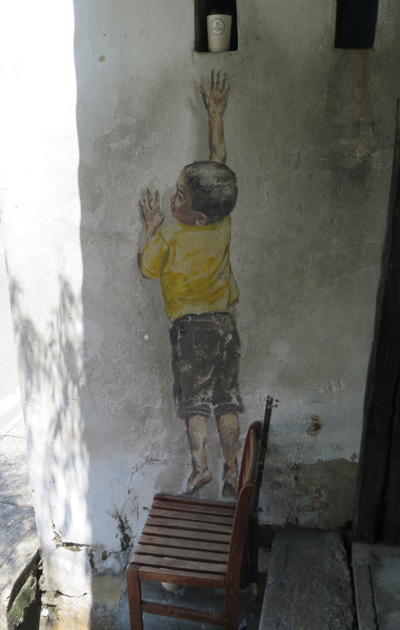




one foot on his knee.
I pass by the old staff quarters of the Blue Mansion - its shutters painted with a diamond pattern in lime green, red and orange. It is lit with the orange glow of the setting sun. Pigeons in front of the building fly upwards disturbed by my arrival.
The streets are also adorned in informative artwork made from thin, black metal bars bent into figures, objects and writing - in the evening the light from the street lamps duplicates the imagery creating shadows on the wall. My favourite is attached to a wall on Love Lane - the outline of an angry women, speech marks

questioning 'where's my husband?' - the metal wording explains that rich men kept there mistresses on this street, hence it's name.
I arrive back at the hostel and hear 3 girls discussing dinner, so I pluck up the courage to ask if I can join. We wander the streets in the dark and eventually settle for a street stall which serves wonton dumpling soup and noodles with pork - both dishes are delicious and cheap.
Caroline is from California. She is petite, pretty and confident. She has just completed an internship in the IT department at Accenture. She has a few months before her role in the Washington DC office starts. She has been traveling alone and has enjoyed her experiences so far.
Endra is from Norway, with typical Scandinavian features of white blonde hair, pale skin and blue eyes. Although she is 27, her childlike pretty features and seeming naïveté makes her appear younger than her years. In actual fact she has lived a fascinating life, spending prolonged periods working in Columbia and Paris. She has just moved to Kuala Lumpur for a four month contract, before moving to Cape Town and then onto Mexico.
Dorine is from Holland - she has a shortcropped quirky haircut, bleached blonde. She's taken a month holiday from work to travel

Malaysia. She's a nurse psychologist and is passionate about her work. She believes quite strongly against the unnecessary overuse of anti depressants. Although her English is not as good as the other 2, we quickly form a bond. She's very chilled out, she makes me laugh and I like her outlook on life.
Day 78 - 15th July 14
Today Dorine, Endra and I take a bus to visit Penang Hill. A train to the top was built by the British to escape the sticky heat in this cooler altitude retreat. The carriages have been modernised and it's a popular tourist destination. The train climbs rapidly up the steep hill, the straight tracks ahead racing past beneath us. At the top, the view is hidden by a dense haze hanging in the sky, the clouds above pregnant with rain.
There's little to see other than a small Hindu temple and a mosque perched on top of the hill. We had planned to walk the 3 hour trek through the jungle down to the Botanical Gardens. We meet a group who have trekked from below who say it's not possible to walk the same path in our current footwear. Endra is keen to avoid the walk and this is a perfect excuse to opt out. I joke with a truck driver in an attempt to persuade him to drive us down the steep road instead. It materialises that this is the mode of transport for the cast who are filming on the hill, so we ask for more information, in a girlish excitement to see the stars of the show. He doesn't know much about it but points us in the direction of the set.
We pass by the first security check point unaccosted. But at the 2nd we are stopped from passing through - actors are walking over the bridge to the set in the distance. We're disappointed that he won't let us take a peek and we ask to see a list of the cast - it is for an English series called An Indian Summer, starring Julie Walters and a bunch of other actors whose names I don't recognise.
Torrential rain appears in slanting showers and a man kindly drives us back to the station. We sit in the cafe with a coffee, waiting for the rain to subside before catching a train back down the hill. We only bought single tickets, but we cheekily use these to get through the barriers - the barcode beeps us through. Endra has lost hers so she frantically pretends to search her bag, while Dorine play acts saying 'But how have you managed to lose such an important document?' We laugh at her formal English, but she fools the guard who kindly lets her pass.
We catch a taxi to the Botanical Gardens, which are not really worth the trip. The grounds are pretty enough with rare tree species planted, formal gardens lined with vibrant flowers, and an attempt at a Japanese garden running past a stream fallen into disrepair. The 'spectacular' waterfall is non existent due to the recent lack of rain, and cannot be reached at a close proximity since it is the town's water supply, so is shielded by an imposing metal fence cornering off the area.
When we reach the centre of town, we eat at the street stalls that we noticed from the bus window. I choose rice and duck with a delicious spicy sauce and then a course of pork fried dumplings. Endra orders

Laksa - a Malay dish of thick rice noodles in a spicy fish broth.
In the evening we join Caroline and two other guys from our hostel: a guy from Ireland who recommends the Jet scheme in Japan that he worked for 10 years ago and a French guy called Gwenvael who works while he travels. Gwenvael has lived in Fiji, Japan and Austalia. He says he evades groups of other French people when traveling as they can be too cliquey and exclusive.
We eat in a food court, which isn't particularly popular with the locals. We try the sushi which is mediocre. There are a lot of waitresses encouraging customers to drink a lot of beer, ready to catch you unaware and top up your glass. There is a stage in the centre on which singers perform amateurishly, sounding more like bad karaoke. The women are wearing out-dated fashion clothes - short skirts, knee high black leather high-heeled boots and cowboy hats. They dance in a sexy style while a few seedy men watch next to the stage. The performance is so distasteful I find it somewhat brilliant.
Eventually the volume of the singing becomes too irritating and we're unable to converse above the microphone's racket, so we return to the street from the previous night to enjoy more beers. At the bar, a large table of tourists pull up chairs for us welcomingly. One of the girls at the table is wearing a short dress too small for her breasts that keep attempting to burst forth. She's American, but Gwenvael thinks she must be English because all the 'sluts' he saw when he visited London were so scantily dressed despite the cold. This makes me laugh. They're all drunk and raucous and we have little interest in chatting to them.
Dorine and I were earlier discussing two famous psychiatric studies: an experiment where the volunteers were split into 2 separate groups of guards and prisoners; and an experiment where the blue-eyed population of a group of volunteers were told they were special in comparison to the brown-eyed - and how scary it is that they so quickly accepted and adapted to their given roles. And now we laugh that as a group we have only known each other for such a short period yet we already seem to have created a superficial feeling of tribalism that we are now disdainful towards this other group. Dorine is leaving to fly to the Perhantian islands and I'm genuinely sad to see her go even after such a short acquaintance.
Day 79 - 16th July 14
The next morning we go to a dim sum restaurant popular with the locals for breakfast. As Caroline's parents are originally from Taiwan, she can speak a little Mandarin so she is able to describe the dishes
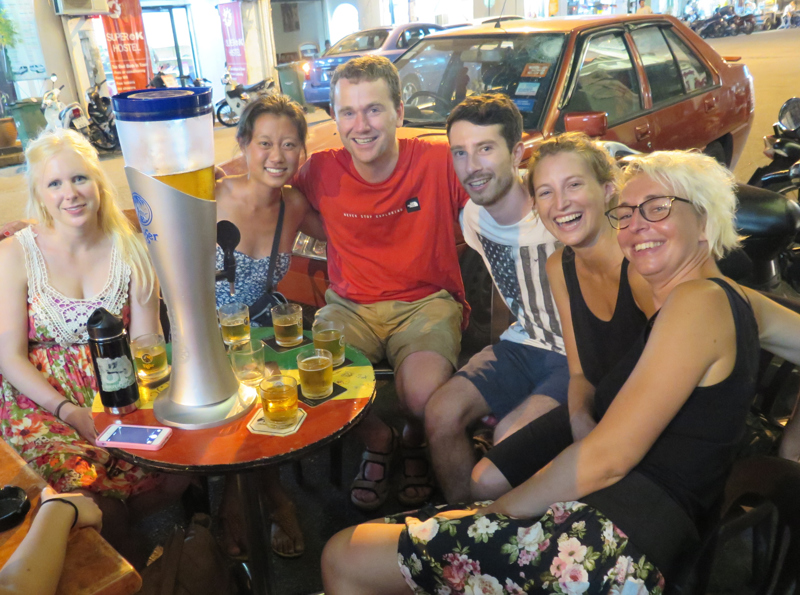
on offer. The steamed buns with a filling just like pulled pork are scrumptious. We agree to meet late afternoon to see the Buddhist temple at sunset.
I walk to Khoo Kongsi mansion - built by one of the Chinese clans in Penang who looked after their fellow men and provided assistance and education, which still continues to this day. The building has been renovated twice before and is spectacular. There are many intricate carvings upon the walls of animals and scenes using different mediums and an elaborately decorated colourful roof in the Chinese style, ornate dragons guarding each corner. Murals are drawn in black and white on the walls inside, one depicting a few generations of the family. One room houses gold plaques listing the people and the universities they have graduated from with this provided funding. Gold floral patterns cover the back wall of the main room and gold covers the tips of the pillars at the entrance.

The tour around the Blue Mansion starts at 2 so I sit and have an iced coffee in a funky, Western style cafe before heading to the mansion. Cheow Fatt Tze originally emigrated from China to Java, a poverty stricken young man, who attempted to make a living from selling water before finding a job in a paper factory and marrying the proprietor's daughter. His rich father in law provided him with the capital necessary to start his own business. He was incredibly successful and went on to be a hugely wealthy man, secretly providing funding throughout his lifetime for the Chinese revolution.
Later on in life he built this beautiful mansion, importing floor tiles, ornate iron railings and stained glass windows from England - illustrating his wealthy status. He worked extremely hard throughout his lifetime, but all his sons from his numerous wives were supposedly innately lazy, so before he died he forbade the mansion to be sold until after the last son's death. They sold all the interior fittings and furniture, and rented out the rooms once there was nothing else left.
The mansion has now been carefully renovated by the new owner, using highly skilled craftsmen employed from China and India, specialists in the colourful ceramic roof decorations. It is now a hotel, but a few rooms are open to the public for brief tours.
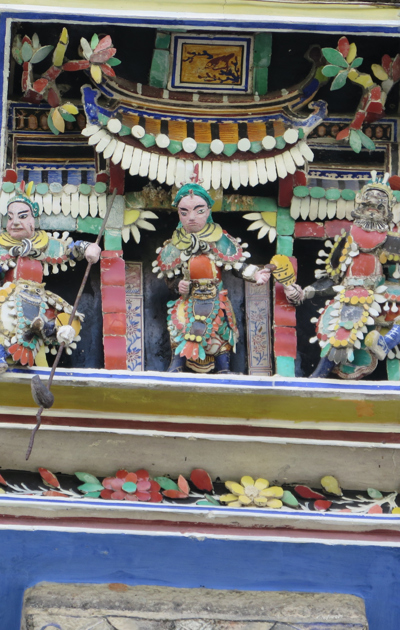
Our guide is incredibly knowledgeable. It materialises that his mother in fact lived in this mansion when she first migrated from China to Penang. She has told him stories regarding the squalor the tenants lived in at this time. The rooms were rented to large families, who cooked inside despite the lack of chimneys, so foul odours perforated the entire building. Everyday the queue outside the 3 toilets was never ending.
He's an interesting man. He only guides once a week and it transpires that he was directly involved in the campaign for George Town to receive protection from Unesco. I ask him if there are any mansions in Penang still in disrepair that I can explore and he tells me about the old house on the seafront that was planned to become the new Raffles hotel, but is now slowly decaying. The owner isn't allowed to knock it down, but it seems he is waiting for it to crumble of its own accord so he can use the land for a new project.
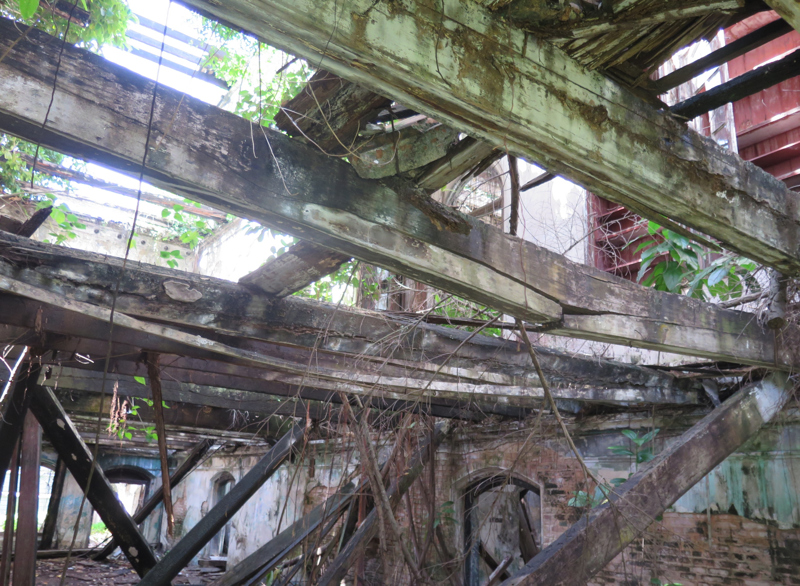
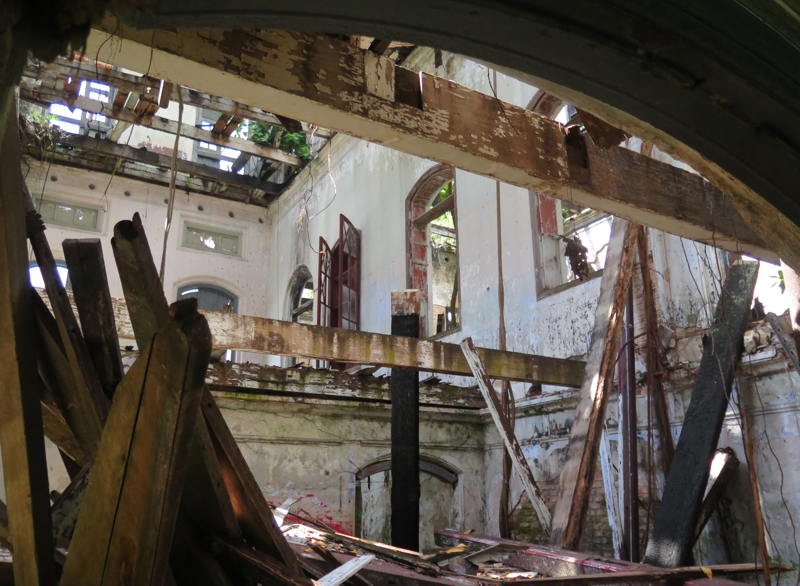
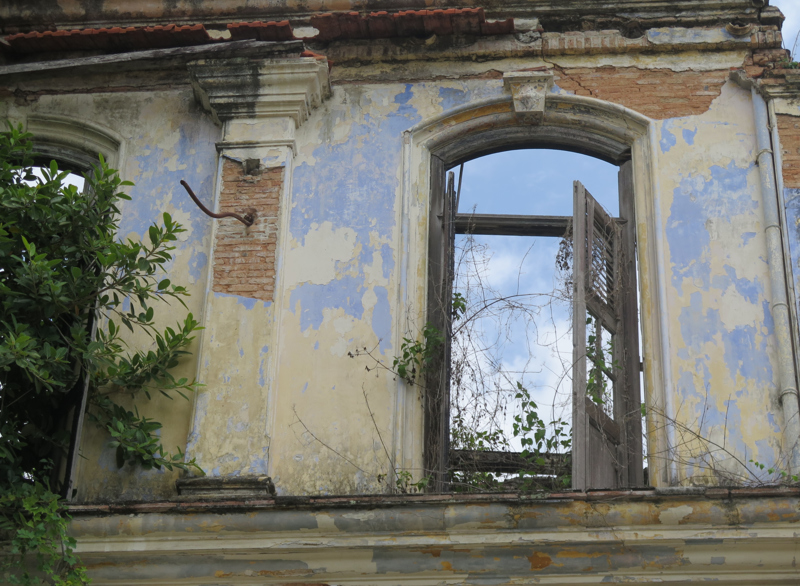
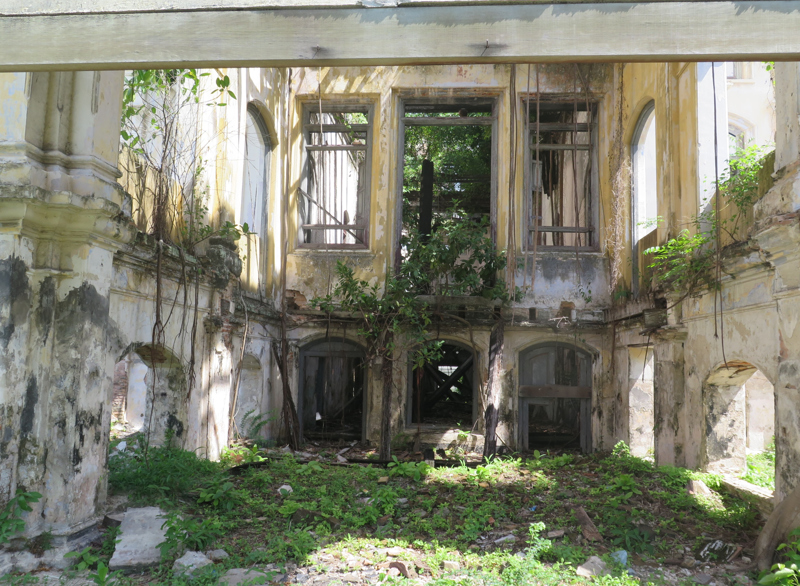
It really is a beautiful colonial building, sitting in the middle of a stony car park. Rectangular columns with curved arches, trees growing out through the windows. I manage to squeeze through a thin gap in the metal fence to explore inside. The infrastructure is non-existent, the 3 storeys have slipped away, the main room looks up to the sky through fallen rafters and hanging vines, no remaining staircase in sight. I want to climb up a slanting beam to view what the upstairs would have looked like, but I hear a dog barking ferociously inside the metal enclosure with me and I am nervous of exploring on my own. I walk around the outside popping my head into the smaller rooms. Bats disturbed by my presence fly towards my face. Worn wooden banisters and shutters sit in the window enclaves, some open or broken. Mould drips down the pale yellow walls, red brick exposed in areas, and remnants of green paint. It is called the Shih Chung
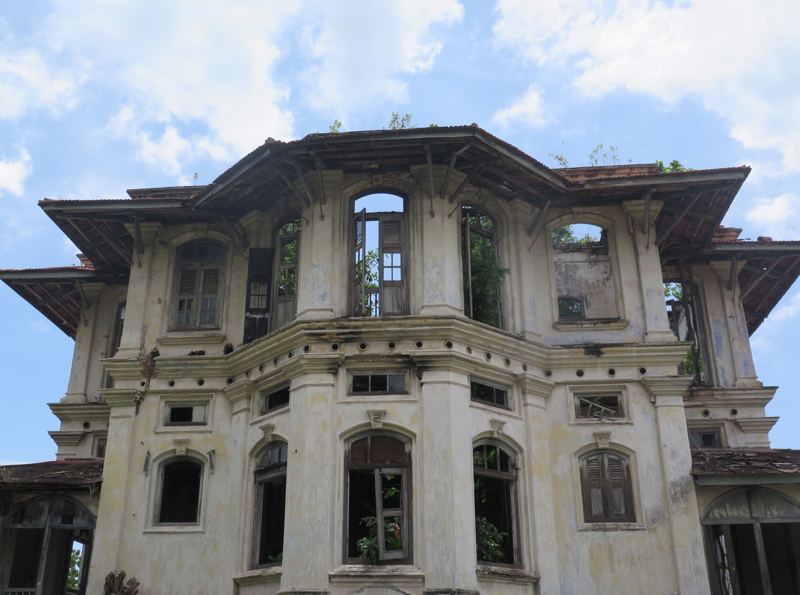
Branch School, the Chinese characters still visible at the front of the building.
I wander through the grave yard next door, which houses Captain Francis Light along with other figures of importance. The pale blue and white paint is flaking from the grave stones and an avenue of old trees attempts to block out the light creating an eerie shade.
Back at the hostel, the guys have not yet returned. Caroline and I reach Little India in time for the Ramadan food. A quarter chicken in a spicy curry sauce, vegetables and pilau rice - it's excellent, but I feel uncomfortably stuffed when we've finished. We catch a bus to the temple, which takes almost an hour, but someone is already locking the gate on arrival.
Disappointed, we carry on up the hill in case there's another entrance and find a road that leads into the temple grounds. The towering gold statue is just out of view and the entrance is blocked by a thick metal fence. We carry on up the hill in hope that it is visible from above, passing construction workers on our way. From the top of a hill we can see the back of the head of the golden statue. Two men are walking around inside and we're puzzled as to how they gained access. On our way down, I notice one of the men who had been inside coming out
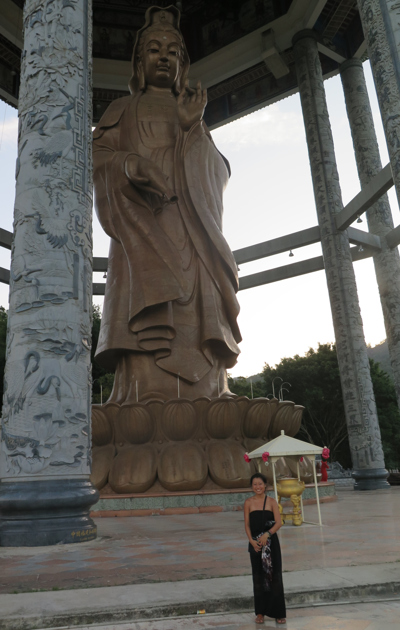
of the building that is being constructed. I accost a man who speaks a little English and ask him how we can get inside. 'Not possible. It's closed, it's closed, come back tomorrow' but tomorrow is my last day, so I ask again, pointing to the man who we have just seen inside. He laughs and there is some shouting backwards and forwards between colleagues - it seems like a conclusion has been reached and he says 'ok, ok, come come'.
He leads us up the slippery rocks around the back into the centre of the place of worship. He's from Bangladesh and has moved here for work. The statue, and the pillars that hold up the roof the statue is housed in, tower up to the heavens and there's an impressive view from here over the city. We take some pictures while he waits to lead us back down and thank him for his time, happy we have accomplished what we came for.
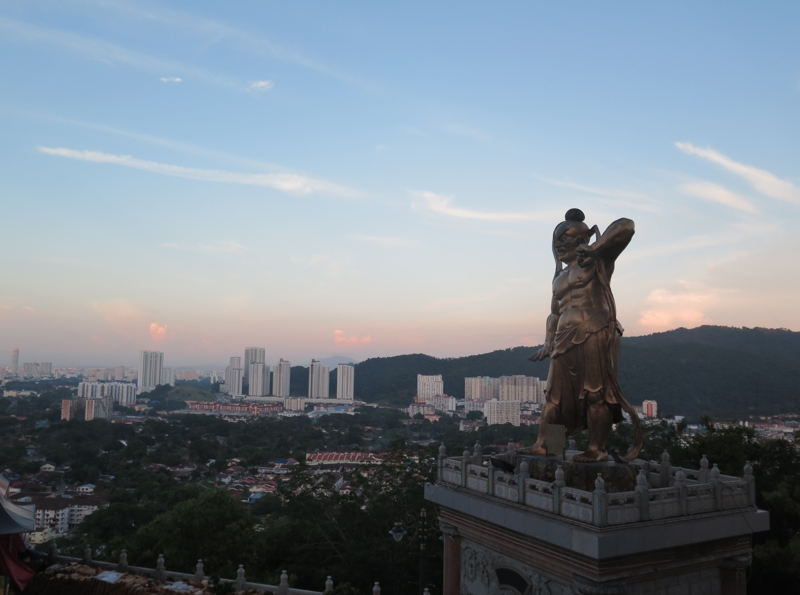
On our way back to the bus stop, a woman on a motorbike drives up to us, all smiles. She tells us it's an important Malaysian day and makes us an origami heart shape from a 1,000 IDR note. She wants to spread peace and love.
Day 80 - 17th July 14
I join Caroline for lunch, eating in a small Malay warung before taking her to visit the derelict mansion. The dog is barking and I can see him in one of the rooms so we don't hang around for long. We walk along the sea front to the clan jetties, where Chinese people moved to when immigrating to the area as fishermen, constructing ramshackle huts above the water. Streets of boardwalks pass the houses on stilts. We feel impolite invading the inhabitants’ privacy. The wooden structures are solid, with low wrought iron fences in front of their porches and electricity wired inside. Some of the stilts are made from old plastic paint containers and large cans filled with cement, stacked on top of each other. Chinese lanterns are strung all along each jetty.
We spend the next hour trying to locate street art we have not yet seen, which proves to be a futile search, but we stumble across crumbling buildings to explore. One room contains a mattress inside. I see an old lady sitting outside a room she has claimed for herself amongst the rubble of bricks and cement and walk down the alleyway

to ask her a question. She shouts at me angrily and waves her hand aggressively for me to leave. 2 dogs on chains leap out of adjacent rooms either side of me, barking ferociously, blocking my path back. I wait for them to calm down before warily retreating.
I collect my laundry from the nearby launderette, but a torrential downpour ensues. I have not time to wait for the rain to subside as I have a bus to catch. By the time I have made the short walk to Roomates, I am completely drenched and have just long enough to borrow a towel and change out of the soaking wet clothes before catching the bus.

1.
Arrival in Jakarta, Pangandaran, Jogjakarta, Malang
2.
Volcanoes - Mt Semeru, Mt Bromo, Mt Ijen
3.
Ubud - a brief Sojourn
4.
Gilli Trawangan - white beaches and turquoise waters
5.
Boat Cruise - past the Komodo Dragons
6.
Flores - traditional villages and Mt Kelimutu
7.
Kuta, Lombok
8.
Baliem Valley - trekking in the mountains and meeting the Dani tribes
9.
Sentani - the festival and the lake
10.
Tana Toraja - Funerals and Burial Sites
11.
Kuala Lumpur - back in civilisation
12.
Cameron Highlands - trekking and tea plantations
13.
Georgetown, Penang - street art and crumbling mansions
14.
Banda Aceh and Pulau Weh - contending with Ramadan; Scuba Diving and snorkelling in paradise
15.
Lake Toba - the Batak people
16.
Bukit Lawang - Orangutans
17.
Unawatuna
18.
Volunteer Sri Lanka - Week 1
19.
Volunteer Sri Lanka Week 2
20.
Kandy and the East Coast
21.
Ella and Colombo
22.
Volunteer Sri Lanka - final week
23.
Earthbound Expedition - Kathmandu, Poon Hill and Chitwan National Park
24.
Back in Kathmandu
25.
Langtang - solo trekking
26.
Kathmandu to Varanasi